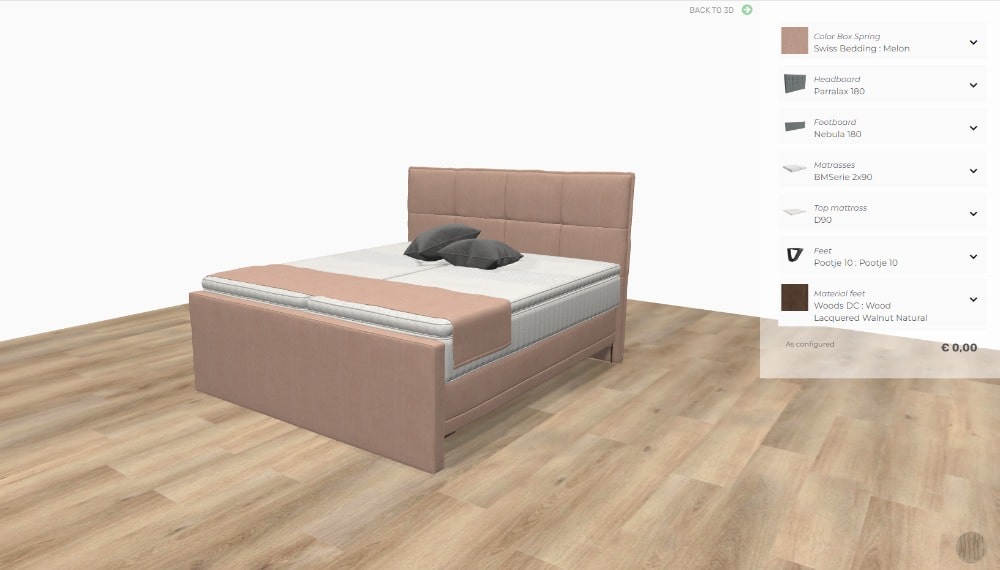Self-service digital commerce – where shoppers configure and purchase products online – is fast becoming the norm. It’s a win-win. Consumers get greater control and convenience over their purchases, and companies can operate more cost-effectively.

Self-service digital commerce – where shoppers configure and purchase products online – is fast becoming the norm. It’s a win-win. Consumers get greater control and convenience over their purchases, and companies can operate more cost-effectively.
The challenge furniture brands face, however, is how to properly showcase all they’ve got in store, including all possible variations, while still keeping it user friendly. Unlike other goods – such as clothing – furniture items are often more complex to configure visually. Bringing in the right visualization tools eliminates these issues and boosts cart conversion rate by up to 50% and increases their average order value by between 30% and 50% (according to Gartner).
Give everyone the right visuals
The recent Gartner market guide for Composable Product Configurators reveals companies using visualization experience a significant lift in their deal win rate and deal size. The evidence is so compelling that 3D visual configuration is soon likely to become a basic customer expectation for buying complex goods such as furniture.
Getting visualization right also leads to cutting costs, such as lowered drafting costs, optimized production lines, and decreased carrying costs. On the flip side, the cost of getting visualization wrong – through poor quality or non-existent visuals – has the opposite effect with increased errors, fewer sales, dissatisfied customers, and costly returns.
For furniture brands that offer items with multiple variations and selectable features, giving customers the right visuals, points to one thing – they are in need of a visual product configurator.

The price of poor visualization
Furniture brands that decide not to deploy a product configurator – or opt for a low-quality solution – are likely to find it ends up costing them in the long run. Here’s what it costs them and the benefits they miss out on as a result:
- Win rates: High-quality visualization leads to faster proposal creation, including CAD drawings or 3D renderings of the ordered product. Without it, proposals are slower and customers are more likely to drop off. With it, companies have seen a 15% increase in add-to-cart rate and a 50% increase in cart conversion rate.
- Revenue: Customers who see the product – and interact with it – at the time of ordering will be more confident that they’ve made the right choice. Customers perceive a furniture brand without a product configurator to be less technologically advanced than its competitors. In fact, some companies have reported a same-store sales increase of 20% after using visualization tools.
- Customer satisfaction: Without high-quality product visualization, self-service channels for furniture brands are effectively closed. Customers, who increasingly expect the option for self-service, will likely go elsewhere to find it.
- Sales opportunities: Product configurators provide an ideal channel to increase average order value by suggesting the best options and add-ons. Not having one is a missed opportunity to upsell or cross-sell. With it, it increases the average order value by between 30% and 50%.
- Dealers inquiries: Putting your product configurators in the hands of dealers, gives them all the answers to questions about color, materials, size, and so on. In fact, it cleans up communication between manufacturers, sellers, and customers. It also reduces the need to keep every single inventory item and physical sample in stock and at trade shows – in some instances reducing costs by 20%.
- Rework costs and return rates: At the point of sale, both the customers and the vendor can see and agree on the configured product. This clarity reduces the chances of errors or miscommunication in the order, which leads to lower return rates and fewer costly reworks. In fact, one company’s rework costs fell from 20% to 1%.
Where to start with visualization
Effective visualization is an essential aspect of successful marketing and sales strategies for furniture brands. It helps showcase products in their best light and enhances the overall customer experience. At the same time, poor visualization can have a negative impact on a furniture brand’s reputation and bottom line.
Getting product visualization right may look complex, but it really doesn’t have to be. With a composable visual product configurator from iONE360, you can build a better customer experience, feasibly showcasing each variant of every product in your furniture range.
We can help you bring high-quality product visualization to your customers, and sales team Connect with us today